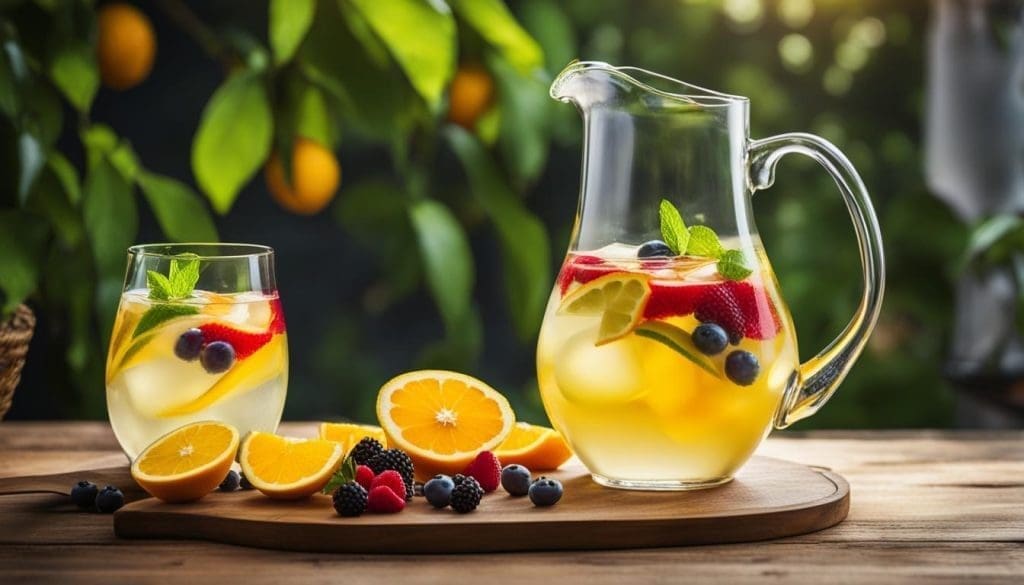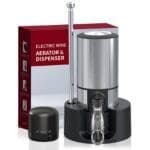If you’ve ever wondered how to craft the most delicious, authentic sangria, you’ve come to the right place. Today, we’ll bring you the 9 best wines for sangria that will elevate your next gathering to the next level. We’ll share sangria wine recommendations, including top wines for making sangria and a guide to sangria wine varieties. So let’s dive right in, shall we?
Key Takeaways
- Choosing the right wine is crucial for delicious, authentic sangria.
- Traditional Spanish wines like Rioja and Garnacha are great options for red sangria.
- Refreshing whites like Albariño and Torrontés work wonders for white wine sangria.
- Balance dryness and fruitiness when selecting your sangria base wine.
- Layering flavours with fruits and optional spirits is the secret to sangria success.
Selecting the Best Wines for Sangria
When it comes to how to make authentic Spanish sangria, there are a few key factors to consider. The seasonality of the fruits you choose, the type of wine you use, and of course, your own personal preferences. Let me guide you through the process of selecting the best wine types for sangria to help you create the most delicious and unforgettable concoction.
First things first, think about the season. Fresh, high-quality produce is crucial for making an impressive sangria. Choosing fruits that are in-season will enhance the drink’s flavour and showcase your attention to detail.
“I recommend using a bold, low tannin, subtly sweet wine for traditional red sangria.” – Chris Chamberlain, E & J Gallo Winery
Sangria is so versatile that it can be made in a variety of styles, using red, white, rosé, and even sparkling wines. To choose the right wine for your sangria, affordability and taste are essential, but never at the expense of quality. In fact, opting for an organic wine can add an environmentally conscious twist to your recipe.
To complement the unique mixture of fruit, wines chosen for sangria should be dry yet fruity, have high acidity, and low tannins. Consider adding fruits like apples, oranges, and strawberries, and perhaps a splash of Cointreau, lemon, orange juice, or sugar to create a harmonious blend. For best results, let your sangria integrate overnight, or at least for several hours before serving. This will allow the flavours to meld together and provide a depth that’s sure to impress your guests.
| Wine Type | Characteristics |
|---|---|
| Red Wine | Bold, low tannin, subtly sweet |
| White Wine | Dry, fruity, high acidity |
| Rosé Wine | Bright, aromatic, balanced acidity |
| Sparkling Wine | Effervescent, fruity, crisp acidity |
Now that you’ve got the basics down, it’s time to consider how to pair sangria with food for a party. As a general rule, pair red sangria with hearty, flavoursome dishes, like smoky grilled meats, and white or sparkling sangria with lighter, more delicate options like seafood, salads, or cheeses.
So, next time you’re planning a get-together or simply looking for a refreshing drink with dinner, remember these tips on selecting the perfect wine for your sangria. Buen provecho!
Crafting the Ideal Red Wine Sangria
There’s something simply enchanting about a well-crafted red wine sangria. The delightful combination of wine and fruit brings a burst of flavour to the palette. So, let’s explore the perfect selections of wines and best practices for crafting a sensational red wine sangria.
Traditional Spanish Reds to Set the Mood
Inspired by traditional Spanish sangria, classic red wines like Rioja and Tempranillo offer an authentic taste of this fruity libation. Rioja wine, with its long history of over a millennium in winemaking, was specifically bottled for sangria in the 1960s.
Its sweet profile harmoniously blends with brandy or rum, making it a quintessential choice for a traditional Spanish sangria. On the other hand, a Tempranillo wine is a spicier, low sugar option that marries perfectly with the sweetness of orange juice for a delectable contrast.
House Reds That Never Disappoint
House red wines never fail to deliver a crowd-pleasing sangria. Fruity and robust Malbec wines present a fantastic option with their sweet plum or berry notes found in Argentine varieties, and the more peppery and acidic qualities of French Malbecs.
Another delightful choice is a Merlot, rich with dark, succulent fruit flavours, such as cherries, blackberries, and plums. Its dessert-like undertones or herbal hints elevate the sangria to new heights.
Red Wine Tips for a Top-Notch Sangria
Pro tip: Balance is key – choose drier wines to counteract the additional sweetness from fruits and mix-ins.
To create an exceptional red sangria, preference leans towards drier wines that can balance the sweetness of fruits and added mix-ins. The charm of sangria is its adaptability, offering a plethora of options like Lambrusco, a sweet yet citrusy wine, or Garnacha, a Spanish favourite boasting natural fruitiness and low tannins.
The perfect sangria blend is accented with seasonal fruit that complements wine selections like these.
Now that you’re equipped with the best traditional Spanish reds and house reds for sangria, it’s time to put these wines to good use. Here are some best practices for crafting that impeccable sangria:
- When selecting fruits, be sure to choose those that are ripe, fresh, and in-season for the most flavourful result.
- For an optimal sangria experience, patience pays off. Allow your mixture to rest for several hours, or better yet, overnight, before serving. This ensures that the wine and fruit flavours meld seamlessly together.
- Wondering how long should you chill sangria before serving? Aim for at least 3-4 hours, although overnight chilling is ideal.
With these tips in mind, you’re well on your way to mastering the art of wine selection and crafting an exquisite red wine sangria. So, gather your favourite wines, fresh fruits, and a touch of spirit, and enjoy the delectable concoction that is sangria.
White Wines That Shine in Sangria
When considering can sangria be made with white wine, the resounding answer is a definite ‘yes’. White wine sangrias exude an air of lightness and refreshment, perfect for warm Australian afternoons sharing drinks and laughter with family and friends. Among the plethora of options, Chardonnay and Sauvignon Blanc emerge as exceptional contenders for creating a delightful white wine sangria.

Chardonnay charms with its versatility, offering a flavour spectrum ranging from apple to pineapple. This medium to full-bodied wine embraces various fruit additions in sangria recipes, making it an excellent choice for any creative twists on traditional sangria.
Sauvignon Blanc, renowned for its grapefruit and grassy notes, boasts high acidity that melds beautifully with an array of fruits and citrus juices. This palate-pleasing combination guarantees a mouthwatering white sangria ideal for any social gathering.
“The best sangrias are like good conversations: refreshing, engaging, and brimming with a mix of bold ingredients and flavours.”
To get you started on your quick and easy sangria for a crowd journey, here’s a recipe tailored for white wines like Chardonnay and Sauvignon Blanc:
| Ingredient | Quantity |
|---|---|
| White wine (Chardonnay or Sauvignon Blanc) | 1 bottle (750ml) |
| Freshly squeezed orange juice | 1 cup |
| Triple sec | 1/2 cup |
| Fresh fruits (apples, oranges, and/ or your favourite fruits) | 2 cups, sliced |
| Sparkling water or lemon lime soda | 1 cup (optional) |
- Combine the white wine, orange juice, triple sec, and sliced fruits in a large pitcher.
- Cover and refrigerate for a minimum of 2 hours, preferably overnight.
- When ready to serve, top the pitcher with sparkling water or lemon lime soda, if desired.
- Pour over ice and enjoy.
As you dive into the world of white wine sangrias, keep in mind the key ingredients for success: an adaptable white wine base, a balance of acidity and fruitiness, and experimentation with fruit and juice combinations. The possibilities are endless, so raise a glass, enjoy the process, and embrace the art of creating superb white wine sangria. Cheers!
Conclusion
As we wrap up our sangria journey, it’s worth recapping some of the top sangria wines to try. From traditional Spanish choices like Rioja and Garnacha to various regional wine options, there’s a wealth of flavours to explore. Whether you prefer red or white sangria, a list of incredible options awaits you, including Albariño, Torrontés, Malbec, and Merlot, to name a few. For the eco-conscious drinkers, some of the best organic wines for sangria, such as Domaine Bousquet, provide a sustainable choice without sacrificing taste.
When it comes to crafting your sangria, remember that the secret to success lies in layering flavours. By choosing the right sangria wine base and adding fresh fruits, you’ll create a delightful medley of taste profiles. Opting for the best wine and fruit combinations for sangria, along with a touch of spirits, can elevate your concoction to legendary status. Pro tip: let your mixture rest overnight for an even more enhanced experience.
In conclusion, planning your sangria recipe is crucial for achieving the perfect outcome. Remember to prioritise wines that balance dryness and fruitiness, avoid heavy oakiness or tannins, and complement the desired blend of fruits and spirits. With a well-crafted sangria wine selection guide and some practice, you’ll be on your way to mastering the art of sangria making. Cheers to a refreshingly fruity future!
FAQ
How do I choose the best wine for making sangria?
Opt for medium-bodied, dry wines without overwhelming oaky or bold flavours. Key factors include affordability, taste, and quality. Spanish wines like Rioja and Garnacha are excellent choices.
Can I make sangria with white wine?
Yes, white wine sangrias offer a light and refreshing alternative to traditional red sangria. Consider Chardonnay and Sauvignon Blanc for their fruity and acidic profiles, which blend well with added fruits and citrus juices.
What are some creative twists on traditional sangria recipes?
Switch it up by using white, rosé, or sparkling wines instead of red wine. Add unique fruit combinations or even try adding organic wines for an environmentally conscious twist.
How long should I chill sangria before serving?
Ideally, let your sangria mixture sit overnight or for several hours before serving. This allows the flavours to integrate and results in a more delicious, well-balanced sangria.
What fruits should I use in my sangria?
Popular choices include apples, oranges, and strawberries, but depending on the wine used, other fruit combinations can also work well. Consider seasonality and freshness of the fruits when deciding your recipe.
How do I pair sangria with food for a party?
Stick to Spanish or Mediterranean dishes like tapas and charcuterie boards. Foods with bold flavours and spices pair well with sangria, as the fruity wine balances out the richness of the dishes.
Can I make a quick and easy sangria for a crowd?
Yes, sangria can easily be made in larger quantities without sacrificing quality. Choose an affordable, fruit-forward wine that complements the chosen blend of fruits and spirits, and adjust the recipe accordingly to suit your guest count.
Source Links
- https://www.liquor.com/best-wine-for-sangria-5093293
- https://insanelygoodrecipes.com/best-wines-for-sangria/
- https://www.thekitchn.com/best-wines-for-sangria-23553713
Sip smarter, subscribe now!
Subscribe for gourmet tips, event updates, travel ideas, and a free e-book on Food Pairings. Start your journey to culinary and travel excellence!















